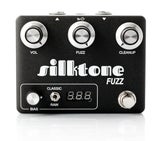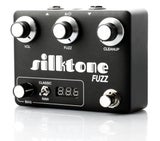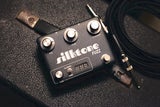- Pedals
- >
- fuzz
fuzz
SKU:
fuzz
$269.00
$269.00
Unavailable
per item
Read the recent premier guitar fuzz review - it got a perfect score!
-------
At the heart of the Silktone Fuzz are two germanium transistors in the classic fuzz face topology, tweaked to get a huge array of tones and fix all the annoyances you get with a typical germanium fuzz. We wanted to nail the awesome tones everybody knows and loves when these transistors are biased to their sweet spot… and also when they’re not. With our active bias monitor you can easily hit them all. Want that oh, so sweet sweet sweet spot? Dial it to ~4.50. Prefer some fat sticky fuzz? Dial it past 7.50. Want spitty gated fuzz? Cool, me too - dial it to ~1.10.
Combine this with the onboard pickup simulator to place this fuzz anywhere in your chain without the normal issues and a cleanup knob to get you into drive territory that rivals the best overdrives out there with beautifully musical germanium color - and you have one of the most useable, versatile fuzzes to date with sooo.. much.. texture.
Scroll down for demo videos!
-------
At the heart of the Silktone Fuzz are two germanium transistors in the classic fuzz face topology, tweaked to get a huge array of tones and fix all the annoyances you get with a typical germanium fuzz. We wanted to nail the awesome tones everybody knows and loves when these transistors are biased to their sweet spot… and also when they’re not. With our active bias monitor you can easily hit them all. Want that oh, so sweet sweet sweet spot? Dial it to ~4.50. Prefer some fat sticky fuzz? Dial it past 7.50. Want spitty gated fuzz? Cool, me too - dial it to ~1.10.
Combine this with the onboard pickup simulator to place this fuzz anywhere in your chain without the normal issues and a cleanup knob to get you into drive territory that rivals the best overdrives out there with beautifully musical germanium color - and you have one of the most useable, versatile fuzzes to date with sooo.. much.. texture.
Scroll down for demo videos!
Sold Out
What’s up with that “CLEANUP” knob?
The cleanup knob is a ton of people's favorite feature and has also made this fuzz a lot of people’s favorite overdrive pedal (?!) This was a huge surprise to me after releasing it! I knew it was useful but the response was crazy. It cleans up the fuzz the higher you push the knob - it works in turn with the pickup sim by mimicking your guitar volume knob to get the cleaner sparkly boost/light overdrive tones a good germanium fuzz face is known for when you roll your guitar volume knob back a bit. It works well as a max fuzz setting to dial in the tone you like and not having to worry about your guitar volume when you engage the pedal. Also useful when the pedal is placed late in the chain to control input gain.
Why does it have a “pickup simulator”?
A lot of fuzzes, including fuzz faces, have really low input impedance so when you put a high impedance guitar in front of them it creates this really nice high-mid hump and roll-off keeping things relatively tame and musical. If you place a buffer or any other pedal with a low output impedance before a typical low impedance fuzz you get this really nasty squealing oscillation and lose all musicality and nuance - if you've ever tried placing a buffered tube screamer or wah before a fuzz you'll know this well. The silktone fuzz fixes this with an onboard pickup simulator so you can place the pedal anywhere in the chain and it behaves as if a guitar is plugged straight into it. I really really like it after a cocked back wah for some cool Q filtering. I worked really hard and tried a ton of different parts to make this as transparent as possible while still working the way it should. It’s an expanded take on the highly circulated Orman circuit.
What is “BIAS”?
Bias is the operating voltage of the transistors, determining how they distort and clip the audio signal. There are a couple common ways most builders approach adjustable bias in a fuzz face circuit, one way is to make both transistors adjustable - things can get messy really easily this way because the transistors interact with eachother and that first transistor is really sensitive to changes - it becomes hard to nail down consistently good tones, especially with temperature sensitive germanium... The other way (I've seen done most) is making only the second transistor adjustable - there's less tonal range this way but it behaves better unless, again, it's germanium and gets thrown off by temperature - then there's no correction in place for the first transistor so it can get all out of whack.
We do it a little different than either of these methods, the cool thing about the fuzz face circuit is that the two transistors are directly coupled so if you change the values around one it affects the other automatically, we use this to our advantage and carefully bias things internally to make both transistors land where they need to be and enable the external bias control to have a huge range of easily accessed tones that all sound great for what they are and can be recalled any time (or temperature) without trouble.
Why an LED bias meter?
With germanium fuzz being so temperature sensitive even bias knob adjustments on other pedals become completely pointless with big temperature swings - leaving you to set by ear every time which isn't always easy. If all you have is a traditional bias knob with no read-out and you have it set to 10 o’ clock or so in a 70 degree room and it sounds great - and then go play outdoors in 90 degree weather or go down to the basement and it’s 50 degrees - your 10 o’ clock position from before will sound completely different, probably causing a gating effect or something and you'll have to find the new spot you like every time. This was always a pain in the ass to me. The active bias monitor on the silktone fuzz takes out any guess work, you just remember the number you like for whatever tone you're after and if the temperature shifts too much the meter will reflect that so you can quickly and easily dial it right back where you like it and forget about it. You don't have to shift it all the time or anything - just with big temperature swings... plus it doubles as an on/off indicator and just looks really fucking cool.
What does that “CLASSIC/RAW” switch do?
The CLASSIC/RAW switch does two things: set to Classic you have the traditional fuzz face bass filtering and bias ratio between the transistors, set to Raw it removes the bass filter to let the whole signal through and extends the bias ratio of the two transistors by shifting the second transistor up higher for an even fatter, boosted sound. The effect of the switch is more apparent when fuzz is dimed and cleanup is at minimum. the bias read-out will also shift about 1 volt higher in Raw mode, for example if you're on the edge of gating around 1.30 in classic mode it would be 2.30 in raw mode. It's pretty easy to follow once you use it. I really like Raw mode for huge thick fuzz tones or for a more focused clean boost type of thing with the cleanup knob pushed way up and the bias around 6.
A great starting point for setting bias is ~4.50 - this is the sweet spot most fuzz faces shoot for and the spot most people will probably hang around - if you want to experiment and really tailor the tone to your taste here are a few points to check out, all these settings were taken in classic mode:
Gated: ~1.10
Vintage: ~2.50
Sweet spot: ~4.50
Fat fuzz: ~6.50
Sticky fuzz: ~7.50
NOTE ABOUT POWER: This fuzz uses a positive ground so no daisy-chaining, if using a power supply brick make sure they are 'isolated' 9VDC center negative (voodoo labs, strymon, mxr iso, 1spot pro, etc are fine)
More stuff...

silktone amp
$2,799.00
Read the recent amp review from Guitar.com - perfect 10!
Harmonic retention and ultra-low noise are the stand-out design feats with this one - allowing all of the good nuanced stuff that is lost on other amps to really come through in focus. The overdrive is soo thick and textured and the cleans are sweet and full even at lower volumes.
A huge range of tones are available with the silktone amp - “Chiffon” mode offers a variety of refined tones from it's TMB tone stack with wide-range Mid control. Cut the mids way back and you get a nice spongy American scooped tone – push the mids and your tone fattens up to the stylings of a bold & dynamic JTM. Push the volume to break up and get a harmonically complex & musical overdrive. “Raw Silk” mode bypasses the tone stack for a huge gain boost – you'll get an incredibly sweet and transparent sound at lower volumes showing off the nuances of your guitar and pedals – push the volume and you can get anything from raw crunch to thick fuzz-like distortion. All of this with a tube driven spring reverb that is as rich as it is versatile. With the combination of the 'Dwell' and 'Mix' controls you can get anything from a smooth & gentle echo to a huge drippy surf effect.
Output: ~12 W/~0.5 W switchable @ 8 ohms
Controls: Vol, Treble, Mid, Bass, Reverb Dwell & Mix, Tone switch for Chiffon (EQ Mode) and Raw Silk (Bypass EQ, Boost)
Tubes: 1 x 12AX7, 2 x 12AT7, 1 x KT66 , 1 x 5AR4
Transformers: Soursound
Speaker: 12" Silktone Ceramic
Dimensions: 21.25” x 18.5” x 10.75” @ 41 lbs
Follow us on Instagram! @silktoneamps
Click here to Pre-order
Harmonic retention and ultra-low noise are the stand-out design feats with this one - allowing all of the good nuanced stuff that is lost on other amps to really come through in focus. The overdrive is soo thick and textured and the cleans are sweet and full even at lower volumes.
A huge range of tones are available with the silktone amp - “Chiffon” mode offers a variety of refined tones from it's TMB tone stack with wide-range Mid control. Cut the mids way back and you get a nice spongy American scooped tone – push the mids and your tone fattens up to the stylings of a bold & dynamic JTM. Push the volume to break up and get a harmonically complex & musical overdrive. “Raw Silk” mode bypasses the tone stack for a huge gain boost – you'll get an incredibly sweet and transparent sound at lower volumes showing off the nuances of your guitar and pedals – push the volume and you can get anything from raw crunch to thick fuzz-like distortion. All of this with a tube driven spring reverb that is as rich as it is versatile. With the combination of the 'Dwell' and 'Mix' controls you can get anything from a smooth & gentle echo to a huge drippy surf effect.
Output: ~12 W/~0.5 W switchable @ 8 ohms
Controls: Vol, Treble, Mid, Bass, Reverb Dwell & Mix, Tone switch for Chiffon (EQ Mode) and Raw Silk (Bypass EQ, Boost)
Tubes: 1 x 12AX7, 2 x 12AT7, 1 x KT66 , 1 x 5AR4
Transformers: Soursound
Speaker: 12" Silktone Ceramic
Dimensions: 21.25” x 18.5” x 10.75” @ 41 lbs
Follow us on Instagram! @silktoneamps
Click here to Pre-order
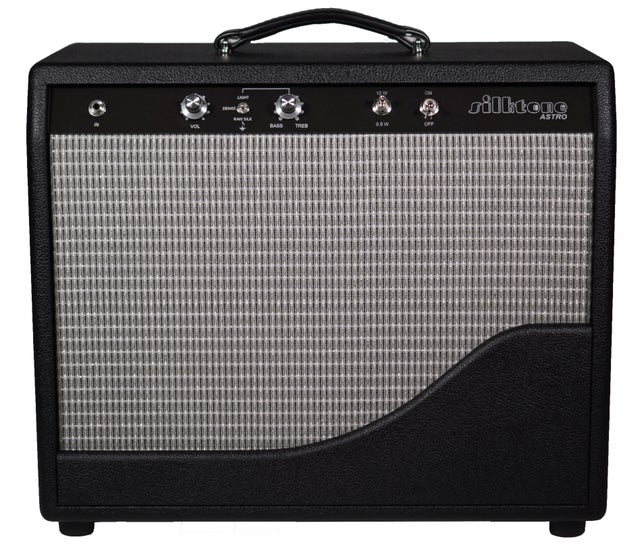
astro (discontinued)
$1,899.00
Features: Unique tone control for simultaneously controlling treble and bass; fixed reactive attenuator
Output: ~12 Watts or 0.5 Watts @ 8 ohms
Controls: Volume, Tone, 3-way voice switch for Light (mid-scoop), Dense (full mids) and Raw Silk (Bypass EQ, Boost), 12W/0.5W
Tubes: 1 x 12AX7, 1 x KT66 , 1 x 5AR4
Speaker: 12" Silktone Ceramic
Dimensions: 21.25” x 18.5” x 10.75” @ 38 lbs.
Follow us on Instagram! @silktoneamps
Scroll down for demo videos!
Output: ~12 Watts or 0.5 Watts @ 8 ohms
Controls: Volume, Tone, 3-way voice switch for Light (mid-scoop), Dense (full mids) and Raw Silk (Bypass EQ, Boost), 12W/0.5W
Tubes: 1 x 12AX7, 1 x KT66 , 1 x 5AR4
Speaker: 12" Silktone Ceramic
Dimensions: 21.25” x 18.5” x 10.75” @ 38 lbs.
Follow us on Instagram! @silktoneamps
Scroll down for demo videos!
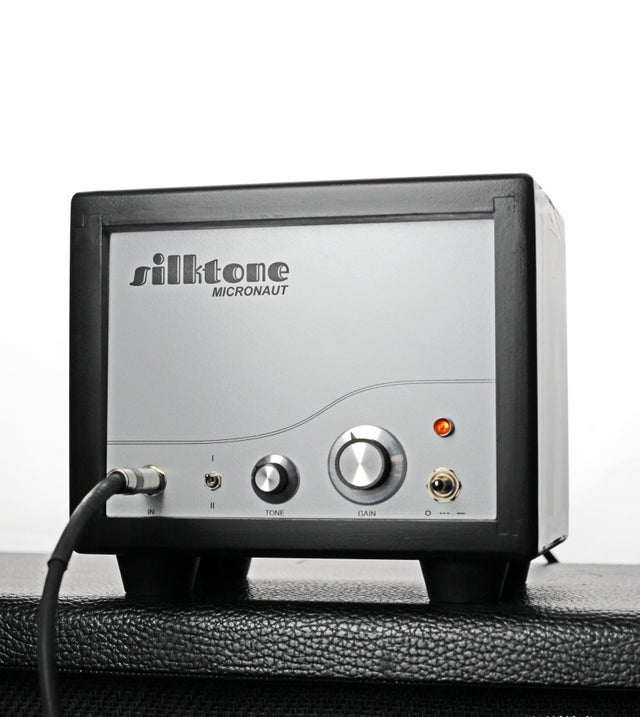
micronaut
$999.00
It's an amp.
It's a drive.
It's a pre.
It's a DI.
It can do clean.
It can do dirty.
Click here to Pre-order
It's a drive.
It's a pre.
It's a DI.
It can do clean.
It can do dirty.
Click here to Pre-order

silktone parallel
$3,999.00
A 25 Watt Parallel Single-Ended Tube Amp!
If it’s not obvious yet, I really like single-ended amps. Their ability to deliver nuance, richness and harmonic texture is unmatched when done well. They offer a different sound quality you simply cannot get from a push-pull amp but single-ended amps to date have been limited mostly to 5-10 watts. I really leaned into this with the design of the original Silktone Amp but I still get one request more than any other: more power.
The easy path would have been a higher powered push-pull version! They’re inherently lower noise, smaller transformers, higher power. It’s just easier and cheaper all around to make a 25W push/pull amp - but what you gain in power you end up losing in sound quality as they also cancel harmonics and introduce crossover distortions I’m not crazy about. I wouldn’t call it worse, just different. I didn’t want that - so I took the hard path. A 25W single-ended amp. I wanted to capture the rich single-ended KT66 tone the Silktone Amp has become known for but expand on it and give it a voice of its own.
Comparing this amp to the Silktone Amp what you’d immediately notice is more volume, more bass, more chime, more texture, more everything. The bass response is insane, it can get super low without saturating or farting out and has such a thick and present delivery of sub harmonics when driven. I love throwing a downtuned guitar or even a bass through it and just letting it rip. The new pine cab makes the upper mids really shine through too, it’s so open and resonant without sacrificing too much focus and sweetness - cuts through a mix like butter. The highs! With the help of the pine cab and bright mode this is our most chimey amp to date but it never gets harsh or piercing. Taking a note from the Micronaut and adding a feedback loop kill switch took this thing even further - it shifts the whole character of the amp to become more open, dirtier and grittier with more touch sensitivity. Mode II plus raw silk is fuzz city, a place I often hang.
From heart-melty jazzy r&b tones, to crunchy hard-rock bangers, to downtuned C-std doomgaze - I use this thing for every variety my tastes require.
-Charles Henry
Click here to Pre-order
If it’s not obvious yet, I really like single-ended amps. Their ability to deliver nuance, richness and harmonic texture is unmatched when done well. They offer a different sound quality you simply cannot get from a push-pull amp but single-ended amps to date have been limited mostly to 5-10 watts. I really leaned into this with the design of the original Silktone Amp but I still get one request more than any other: more power.
The easy path would have been a higher powered push-pull version! They’re inherently lower noise, smaller transformers, higher power. It’s just easier and cheaper all around to make a 25W push/pull amp - but what you gain in power you end up losing in sound quality as they also cancel harmonics and introduce crossover distortions I’m not crazy about. I wouldn’t call it worse, just different. I didn’t want that - so I took the hard path. A 25W single-ended amp. I wanted to capture the rich single-ended KT66 tone the Silktone Amp has become known for but expand on it and give it a voice of its own.
Comparing this amp to the Silktone Amp what you’d immediately notice is more volume, more bass, more chime, more texture, more everything. The bass response is insane, it can get super low without saturating or farting out and has such a thick and present delivery of sub harmonics when driven. I love throwing a downtuned guitar or even a bass through it and just letting it rip. The new pine cab makes the upper mids really shine through too, it’s so open and resonant without sacrificing too much focus and sweetness - cuts through a mix like butter. The highs! With the help of the pine cab and bright mode this is our most chimey amp to date but it never gets harsh or piercing. Taking a note from the Micronaut and adding a feedback loop kill switch took this thing even further - it shifts the whole character of the amp to become more open, dirtier and grittier with more touch sensitivity. Mode II plus raw silk is fuzz city, a place I often hang.
From heart-melty jazzy r&b tones, to crunchy hard-rock bangers, to downtuned C-std doomgaze - I use this thing for every variety my tastes require.
-Charles Henry
Click here to Pre-order


